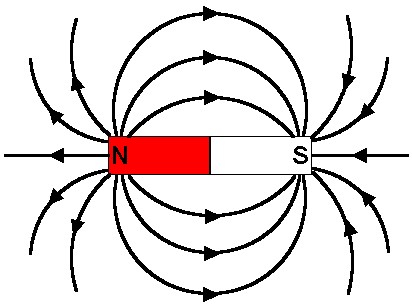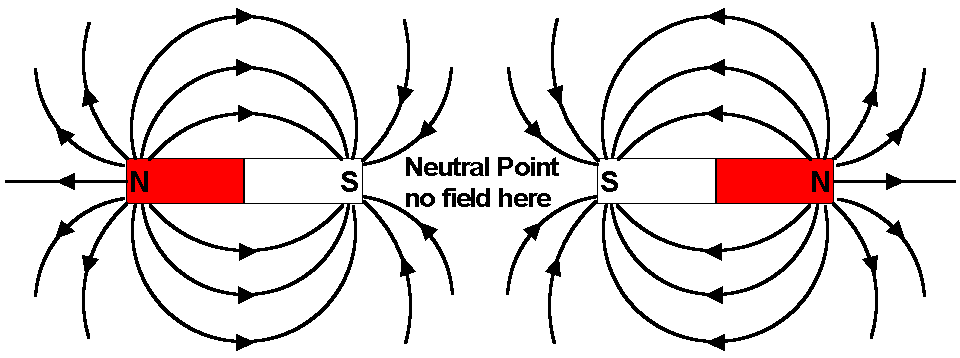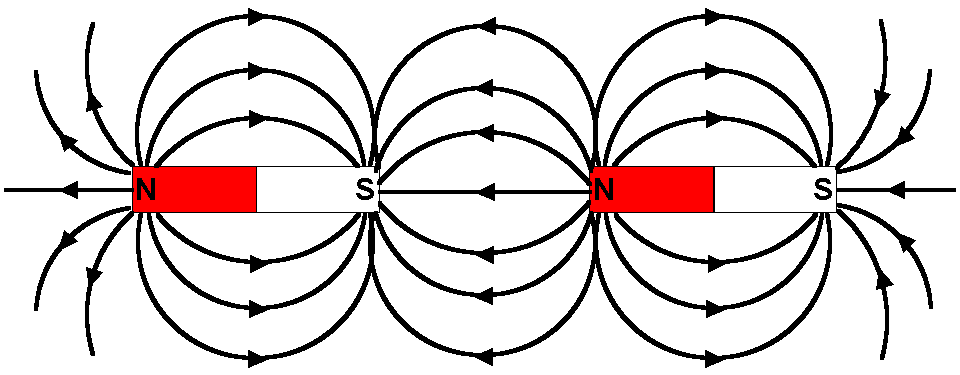|
Magnets have 2 poles, north and south. if a magnet is broken in half then a new north and south pole is formed. Materials can be magnets as well as magnetic. The difference is small but important. Magnetic materials such as iron/steel nickel or cobalt will be attracted to both the north or south pole of a magnet but a magnet will repel another magnet if the same poles are presented to each other.
All magnets have magnetic field lines running from north to south. These are concentrated at the poles where the lines are closest together.

When two like poles are put together they repel each other. the field lines show why this is the case.
When two unlike poles are placed together they attract each other as can be seen in this third video 
When reading this next section you must read it CAREFULLY several times.
The North Magnetic Pole of the Earth is actually a "south" Pole!
Even if it might seem a bit strange to claim that the North Pole is somehow a south pole, it's a curious fact of history and definition and takes a bit of thinking about, after which it makes more sense.
If you were assembling a scale model of the Earth, and you were about to put a bar magnet inside to give the model earth its magnetic field, which way round would you put the magnet? To many people, it's so obvious that it doesn't take thinking about, that you'd put the north pole of the bar magnet towards the end of the earth that had Canada, Greenland, and Siberia on it, rather than the end that had Antarctica and Australia on it. But, odd as it may seem, this would be incorrect. The true polarity of the earth is the other way round, with the bar-magnet equivalent of the north pointing in the direction which is normally downwards on conventionally up-down aligned globes of the world. (I'll get around to explaining why globes are that way up later, but it's just an odd convention).
southness and northness of the poles of magnets is something that can be tested, and you could take a set of randomly shuffled unmarked magnets and easily detect which way round their poles were. You could line them all up with north at the top, but if "the earth" was one of the magnets, it would end up being placed the opposite way round to that which would be expected!
But that's just SILLY, isn't it?! How can that possibly be?
The answer is there to be seen in history. Quite simply, magnets were made and labelled with their "north pole", but in truth "north pole" on a magnet is short for "North seeking pole". Or, to put it another way, the end which seeks North, is attracted to North, and which (if it's a magnetic compass needle) will point towards North on a map. There's no doubt about which end of the earth is the North and which end is the South. It's just that magnetic compass needles are labelled according to which way they point or seek. As opposites attract, the North-seeking end of a magnet will be attracted to a the "magnetic southness" which is the North pole of the earth.
A compass needle has the pointy end painted as north, because it is attracted to that end of the earth. The compass needle itself is a magnet, and it's pointy end is its north. So, what happens if you put a compass near a bar-magnet? Does it point to the south or north end of the magnet. Answer: The compass points towards the south pole of the bar-magnet.
Another way to think about it is to consider the fact that all magnets whether they be as small as compass needles or as mid-sized iron magnets or as big as the magnet inside the earth, all have this "opposites attract" property to them. So, with a bit of thinking about it, you can see which way round the polarity of the planet's internal magnet has to be... with south at the North pole and with north at the South pole!
(The capitalisation convention on this section is that geographical things have initial letter capitals (e.g. North pole near Greenland), and magnetic polarity things are not capitalised (e.g. a magnet's north pole)).
The link below will also help to explain magnetism. This is an external link and you should go to the next button rather than the back button to go over the subject matter in this topic. it covers magnetism, and electromagnetism over 5-6 pages.
http://www.ndt-ed.org/EducationResources/HighSchool/Magnetism/twoends.htm
Do go further forwards or back if you want to but these areas will not be examined and might actually confuse you more so you have been warned!!!
|


